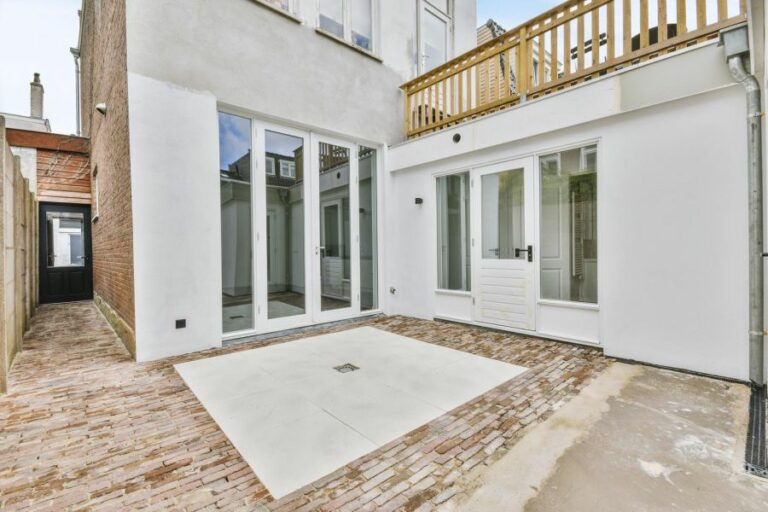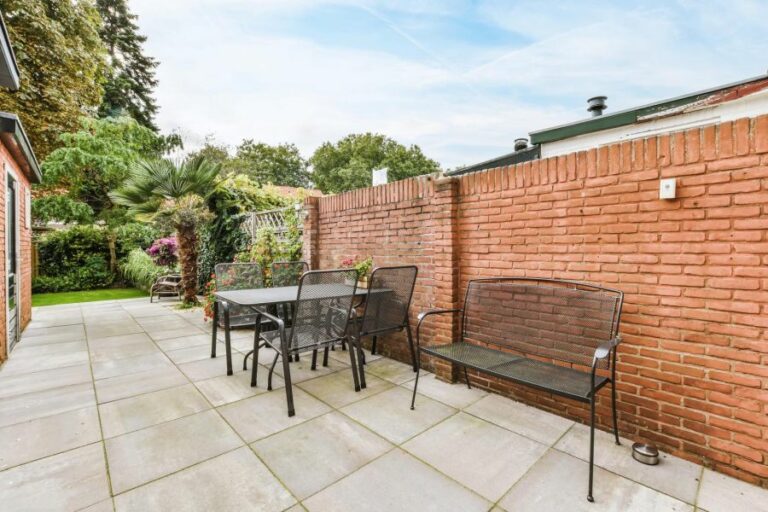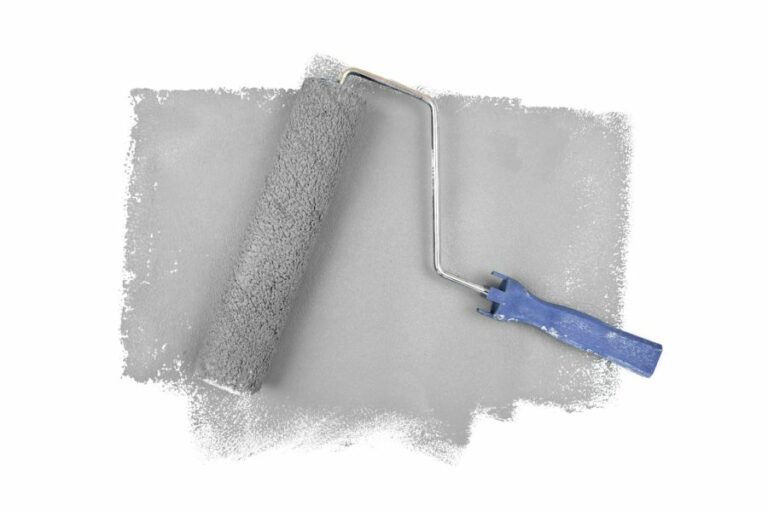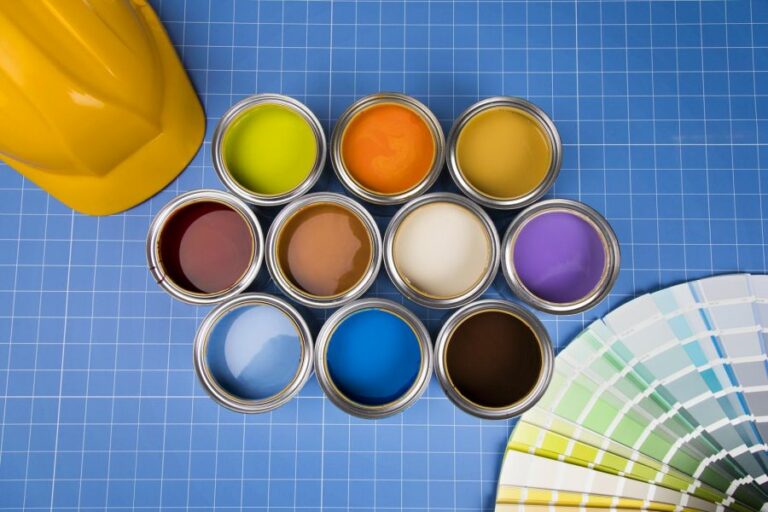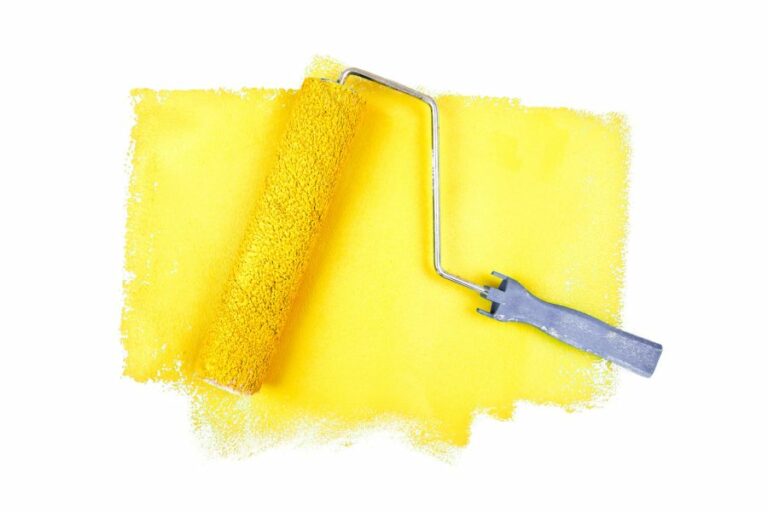Outdoor Concrete Paint Colors, 25 Things You Should Know
Explore the transformative power of outdoor concrete paint colors in this insightful blog post. Discover how the right shade enhances the visual appeal of your exterior spaces and preserves and protects your concrete surfaces. Unleash your creativity and get inspired by the latest trends, innovative ideas, and easy-to-follow guidelines to revamp your patios, driveways, and walkways. Make your outdoors an extension of your minimalist, bold, or timeless style.
Outdoor concrete paint colors:
Outdoor concrete paint colors provide a durable, cost-effective solution for enhancing outdoor spaces such as driveways, pathways, patios, and pool decks. Available in various types, including acrylic, epoxy, and urethane paints, outdoor concrete paints offer aesthetic appeal and ease of maintenance. Factors such as surrounding architecture, sun exposure, desired finish, and safety should be considered when choosing a paint color. Popular color schemes include earth tones, monochromatic, contrasting colors, and greyscale, offering various options for complementing property designs and creating visually appealing environments.

Discover the power of outdoor concrete paint colors to transform your space from vibrant hues to muted tones. Explore the latest trends, best application techniques, and expert tips to create a beautiful, long-lasting exterior aesthetic. Let’s paint a masterpiece together!
Contents
- 1 Exterior Concrete Surface Paint Color Options
- 2 Which color of paint is most suitable for concrete surfaces?
- 3 What is the Most Suitable Type of Paint for Exterior Concrete Surfaces?
Exterior Concrete Surface Paint Color Options
Enhancing the look of your concrete surfaces can do wonders for your outdoor space, from driveways and pathways to patios and pool decks. One way to achieve this transformation is by using outdoor concrete paint colors.
• Benefits of Using Outdoor Concrete Paint Colors
Outdoor concrete paint colors offer several benefits over other treatments, such as stains or sealers. Here are some reasons why you should consider using outdoor concrete paint colors for your project:
- Durability: Outdoor concrete paint is designed to withstand harsh weather conditions, foot traffic, and UV damage. This makes it a long-lasting and cost-effective solution to protect your concrete surfaces.
- Aesthetic Appeal: Painting your concrete surfaces allows you to choose from a wide array of colors and designs that can add visual interest and appeal to your outdoor space.
- Easy Maintenance: Well-applied concrete paint creates a barrier that prevents stains and dirt from penetrating the concrete, making it easier to clean and maintain.
• Types of Concrete Paint
When it comes to outdoor concrete paint colors, there are several types of paint to choose from. Each comes with its advantages and disadvantages. Some of the popular types include:
- Acrylic paints are water-based and known for their versatility and ease of use. They are easy to clean up with soap and water, offer good adhesion to concrete surfaces, and are UV-resistant.
- Epoxy: Epoxy paints are durable and known for their excellent resistance to chemicals, abrasion, and water. They are ideal for high-traffic areas and offer a glossy finish. However, they can be difficult to apply and may need a professional touch.
- Urethane: Urethane paints are another durable option for outdoor concrete surfaces. They are UV-resistant and offer excellent gloss retention. However, they can be more expensive than other options and require careful surface preparation.
• Factors to Consider When Choosing Outdoor Concrete Paint Colors
When it comes to selecting the perfect outdoor concrete paint color for your project, several factors come into play. Consider the following when making your decision:
- Surrounding Architecture and Landscaping: Choose a paint color that complements your outdoor space’s existing colors and design elements. This will help create a cohesive and visually appealing environment.
- Location and Sun Exposure: Lighter colors tend to reflect sunlight and keep surfaces cooler, making them a better choice for areas that receive intense sun exposure. Darker colors absorb sunlight, which can cause surfaces to become hot and less comfortable to walk on.
- Desired Finish: Some outdoor concrete paint colors come in various finishes, such as matte, semi-gloss, or gloss. Consider the desired finish when selecting a paint color, as it can impact the final appearance and maintenance requirements.
- Safety: In areas where slip resistance is crucial, such as pool decks, consider using paint colors that include slip-resistant additives. These additives can help improve traction and prevent accidents.
• Popular Outdoor Concrete Paint Color Schemes
Choosing the right color scheme can make all the difference in transforming your outdoor concrete surfaces. Here are some popular outdoor concrete paint color schemes to inspire your project:
- Earth Tones: Earthy color schemes are versatile and timeless, making them popular for outdoor concrete surfaces. Consider using colors such as beige, brown, terra cotta, or deep greens to create a natural and warm aesthetic.
- Monochromatic: A monochromatic color scheme uses various shades of a single color, providing visual interest while maintaining a cohesive look. This is suitable for modern and minimalist outdoor spaces.
- Contrasting Colors: Adding a pop of contrasting color can create a bold and dynamic effect. For example, pair neutral-toned concrete surfaces with vibrant shades of blue or orange to create visual interest and focal points in your outdoor space.
- Greyscale: A greyscale color scheme featuring different shades of grey is ideal for contemporary and industrial-style outdoor spaces. This color scheme offers a clean, minimalistic appearance that effortlessly lends to sleek and modern designs.
In conclusion, outdoor concrete paint colors offer a durable and long-lasting solution for enhancing the appearance of your outdoor spaces.
By considering factors such as the surrounding architecture, sun exposure, desired finish, and safety, you can choose the perfect color scheme that complements your property and creates a visually appealing environment.
Whether you opt for earthy and natural hues or bold and contrasting shades, your outdoor concrete surfaces will be transformed into striking focal points for years to come.
Which color of paint is most suitable for concrete surfaces?
Concrete is a versatile and widely used material for various construction purposes, including building walls, floors, and even decorative elements. One of the essential factors to consider when dealing with concrete is choosing the appropriate paint color to enhance its appearance and durability.
• Why Paint Matters: The Importance of Choosing the Right Color for Concrete
The durability and the aesthetic appeal of your concrete structure largely depend on the type of paint used. Choosing the wrong paint color can lead to a dull-looking structure while also causing the paint to chip or wear off quickly. The right paint color for concrete can provide numerous benefits, including:
- Enhancing the facade and overall appearance of the structure
- Protecting the concrete surface from moisture damage and chemical reactions
- Making the structure more resistant to wear and tear
- Reducing maintenance costs by prolonging the life of the concrete surface
• Factors to Consider When Selecting Paint Color for Concrete Surfaces
– Paint Type
When it comes to painting concrete surfaces, not all paints are suitable. To ensure you get the best results, using paint specifically designed for concrete is essential. Some of the best paint options for concrete surfaces include:
Epoxy Paint
Epoxy-based paints are known for their durability and long-lasting finish. This type of paint provides excellent protection against moisture, weathering, and chemical spills, making it a top choice for industrial and commercial projects that require heavy-duty protection.
Acrylic Paint
Acrylic paint is a water-based paint that is easy to apply and fast-drying, making it suitable for DIY projects or residential applications. This type of paint is also resistant to UV damage and mild chemicals, ensuring a durable finish.
Masonry Paint
Masonry paint is specially formulated for painting concrete and other porous surfaces. It provides a breathable finish that allows trapped moisture to escape, preventing water damage or mold growth.
– Environmental and Safety Factors
When selecting a paint color for concrete surfaces, it is essential to consider its impact on the environment and the safety of the people in the surrounding area.
Low VOC Content
Volatile organic compounds (VOCs) can be released into the air during the paint application process, causing harm to the environment and human health. Opting for paint with a low VOC content is an environmentally friendly choice that also reduces the risk of respiratory issues and irritation.
Reflective Paint Color
In hot and sunny climates, choosing a light and reflective paint color can help reduce the absorption of heat by the concrete surface. This can lead to lower cooling costs for your building and reduce the urban heat island effect.
– Durability and Maintenance Costs
A premium-quality paint that offers long-lasting protection and requires minimal maintenance is an essential factor to consider.
High-quality paints can withstand environmental factors such as sunlight, rain, and temperature changes, which prolong the life of the concrete surface and reduce maintenance costs.
• Choosing the Ideal Paint Color for Your Concrete Project
Now that you know what factors to consider when selecting paint for concrete surfaces, let’s look at various color options to help you make an informed decision.
– Neutral Colors
Neutral colors are timeless and versatile, making them an excellent choice for a variety of concrete projects. Some popular neutral colors for concrete surfaces include:
- Gray: Gray is the natural color of concrete and lends an industrial feel to the surface. It is also practical, as it is less likely to show dirt and stains.
- Beige or Cream: These soft, light colors create an inviting and warm atmosphere while maintaining a clean and professional appearance.
- White: White projects a modern and minimalist look while also reflecting sunlight, making it an environmentally friendly choice for reducing heat absorption.
– Earthy Tones
Earthy colors such as brown, terracotta, and olive green work well for concrete surfaces in outdoor areas like patios, pathways, and retaining walls. These colors blend seamlessly with surrounding natural elements and can add warmth to the overall aesthetic.
– Vibrant and Bold Colors
Vibrant colors can create a striking visual impact and draw attention to specific features or areas of your concrete surface. However, it is essential to be cautious when using bold colors as they can become outdated quickly or create contrast with other elements in the surrounding space.
• Expert Recommendations
Based on years of experience in the concrete industry, I recommend the following approaches when choosing paint colors for concrete surfaces:
- Consider the architectural style and color palette of the surrounding environment. Selecting a color that complements the rest of your property will create a cohesive and visually pleasing aesthetic.
- Test a small area of your concrete surface with the chosen paint color before committing to the entire project. This will give you a better idea of how the color will look when applied to the concrete.
- If you are unsure which color to choose, consult a local professional or interior designer. They can provide valuable insights and advice that will help you make an informed decision.
In conclusion, choosing the right paint color for concrete surfaces involves assessing the type of paint, environmental impact, and durability.
By considering these factors and exploring various color options, you can find the perfect paint color that will enhance and protect your concrete structure for years to come.
Type of Paint | Color | Advantages |
|---|---|---|
Acrylic Latex Paint | Light Gray | Easy to apply, low odor, fast drying |
Epoxy Paint | Light Gray or Neutral Colors | Long-lasting, highly durable, resistant to stains and chemicals |
Concrete Stain | Natural Earth Tones | Enhances concrete texture, UV stable, weather-resistant |
Urethane Paint | Light to Medium Colors | Strong adhesion, resistant to abrasion and chemicals, UV stable |
What is the Most Suitable Type of Paint for Exterior Concrete Surfaces?
Exterior concrete surfaces require tough, long-lasting paint that can withstand harsh weather conditions, moisture, and UV exposure.
Several types of paint on the market are specifically designed for use on concrete, but not all of them may provide the desired results in terms of durability, finish, and appearance.
• Acrylic Latex Paint
Acrylic latex paint is a popular choice for exterior concrete surfaces due to its excellent adhesion properties, easy application, and durability. This type of paint is water-based, which means it is easy to clean up with soap and water and has a low odor compared to other types of paint.
– Pros of Acrylic Latex Paint
- Dries quickly
- Resistant to fading, chalking, and peeling
- Provides excellent color retention
- Environmentally friendly
- Low VOCs (Volatile Organic Compounds)
– Cons of Acrylic Latex Paint
- May not adhere well to previously painted surfaces
- Not as durable as other types of paint
As a personal recommendation, I would suggest using this type of paint for general-purpose exterior concrete surfaces such as walls, fences, and foundations. It is important to prepare the surface properly, including cleaning and priming, to ensure the best adhesion and performance of the paint.
• Epoxy Paint
Epoxy paint is a durable and long-lasting paint option that consists of a two-part system: a resin and a hardener. When applied on exterior concrete surfaces, it creates a strong bond and is resistant to chemicals, weather, and moisture.
– Pros of Epoxy Paint
- Extremely durable and long-lasting
- Resistant to chemicals, abrasion, and moisture
- Creates a strong bond with the concrete surface
- Available in various sheens and colors
– Cons of Epoxy Paint
- Requires careful mixing and application
- Longer drying time
- Higher cost compared to other types of paint
- Difficult to remove once cured
In my experience, epoxy paint should be used for heavy-duty exterior concrete surfaces that require higher durability and protection, such as driveways, garage floors, and walkways.
It is essential to carefully follow the manufacturer’s instructions for mixing and application, as improper use may lead to a weak bond or uneven finish.
• Elastomeric Paint
Elastomeric paint is a high-performance coating that is specifically designed to provide a waterproof and flexible barrier on exterior concrete surfaces. It contains elastic properties that allow it to expand and contract with the surface, preventing cracks and providing excellent protection against water infiltration.
– Pros of Elastomeric Paint
- Highly water-resistant and weatherproof
- Flexible and crack-resistant
- Durable and long-lasting
- Excellent adhesion to concrete surfaces
- Can help reduce energy costs due to its insulating properties
– Cons of Elastomeric Paint
- Requires special application techniques and equipment
- May not adhere well to previously painted surfaces
- More expensive than other types of paint
Elastomeric paint is a great choice for exterior concrete surfaces that require enhanced protection against moisture and cracking, such as stucco walls, concrete block walls, and foundations.
Proper surface preparation and application techniques are crucial to ensure the performance and longevity of this type of paint.
• Concrete Stain
Concrete stain is not a traditional paint but rather a semi-transparent coating that penetrates the surface of the concrete and reacts chemically with it, creating a long-lasting color and finish.
It is available in water- and acid-based formulations, offering different levels of translucency, color, and durability.
– Pros of Concrete Stain
- Provides a natural and unique look on the concrete surface
- Extremely durable and long-lasting
- UV and fade-resistant
- Requires very little maintenance
– Cons of Concrete Stain
- Limited color options compared to traditional paint
- Requires proper surface preparation and application techniques
- May not cover or hide surface imperfections
I recommend using a concrete stain for exterior concrete surfaces that would benefit from a more natural and distinct appearance, such as patios, walkways, and decorative concrete elements.
Keep in mind that the final result will depend on the type of stain used and the characteristics of the concrete surface.
• Conclusion
The choice of paint for exterior concrete surfaces will depend on several factors, such as the type of surface, desired appearance, durability requirements, and budget.
Acrylic latex paint is a versatile and affordable option for general-purpose surfaces, while epoxy paint or elastomeric paint may be better suited for heavy-duty or moisture-prone areas. Concrete stain can be an excellent alternative for those looking for a unique and natural appearance.
In any case, proper surface preparation and application techniques are crucial to ensure the performance and longevity of the paint. Always follow the manufacturer’s recommendations and, if necessary, consult with a professional to achieve the best possible results for your exterior concrete project.
Type | Description | Pros | Cons |
|---|---|---|---|
Acrylic Latex | Water-based acrylic latex paint designed specifically for concrete surfaces | Durable, resistant to UV rays, maintains color, and easy to clean | May have difficulty adhering to extremely smooth concrete surfaces |
Elastomeric | Waterproof coating that expands and contracts with the concrete surface | Resistant to water damage, cracking, and peeling; good for covering minor imperfections | Thicker and more expensive than other paints, requires a primer for best adhesion |
Epoxy | A two-part paint that mixes a resin and hardener for a strong, chemical-resistant coating | Extremely durable, provides a shiny finish, and is resistant to chemicals, oils, and stains | Difficult to apply; must be mixed correctly, and the surface requires proper preparation |
Concrete Stain | Penetrating stain that reacts chemically with the concrete surface to produce a unique color | Long-lasting, UV resistant, and can create a variety of finishes and appearances | Requires proper surface preparation and may not produce consistent color on all surfaces |

